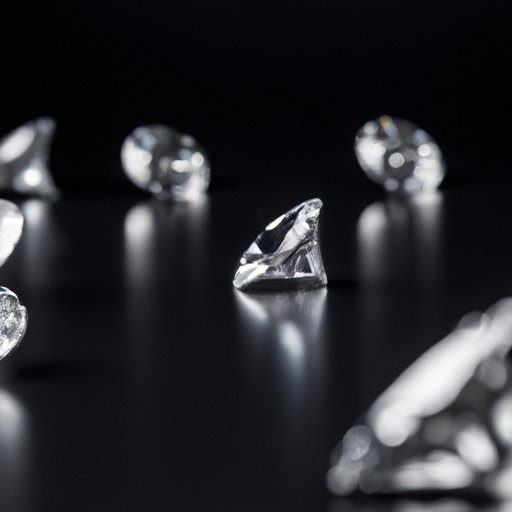Introduction
Diamonds are a unique and valuable resource that has been prized for centuries. These precious gems are found all over the world, but their exact origins and locations can often be mysterious. In this article, we’ll explore the geography and economics of diamonds, as well as their potential in space and their environmental impact. By the end, you’ll have a greater understanding of where diamonds come from and what makes them so special.
Geology of Diamonds: An Overview of Where They’re Found
Diamonds are formed deep within the Earth’s mantle, under extreme heat and pressure. They are then brought to the surface by volcanic eruptions or through the process of erosion. While some diamonds are found in ancient riverbeds or on beaches, most of the world’s diamonds are mined from kimberlite pipes or alluvial deposits.
History and Modern Methods of Diamond Mining
The history of diamond mining dates back to ancient Egypt, with evidence of early miners using primitive tools to dig up the precious stones. Today, diamonds are mined using advanced technologies such as hydraulic excavators, bulldozers, and large-scale open pit mining. The exact method of mining depends on the type of deposit being mined and the size of the diamonds being sought.
Types of Diamond Deposits Around the World
Diamonds are found in many countries around the world, including Russia, Australia, Canada, South Africa, India, and Brazil. Each country has its own unique type of diamond deposit, from kimberlite pipes to alluvial deposits. The specific type of diamond deposit will determine the methods used for extracting the diamonds.

The Economics of Diamonds: How Their Rarity Impacts Their Value
Diamonds are one of the most valuable resources in the world, due to their scarcity and beauty. The price of diamonds is determined by a number of factors, including supply and demand, quality, and market conditions. Understanding these factors can help give you a better sense of why diamonds are so expensive and why they remain popular.
Factors Determining the Price of Diamonds
The price of diamonds is determined by a number of factors, including their size, clarity, color, cut, and carat weight. Larger diamonds with higher clarity and color grades tend to be more expensive than smaller, lower-grade diamonds. Other factors, such as the current market conditions and the availability of diamonds, can also affect the price of diamonds.
How Supply and Demand Affect the Price of Diamonds
The supply and demand for diamonds can also have a major impact on their price. When there is a high demand for diamonds, their prices tend to increase. On the other hand, when the supply of diamonds is low, their prices may go up even further. This is because diamonds are considered a finite resource, making them both valuable and rare.
Diamonds in Space: Are There Any Out There?
In recent years, scientists have begun exploring outer space for potential diamond deposits. While diamonds are not likely to be found on planets or moons, they may exist in asteroids and other bodies in our solar system. If diamonds are discovered in space, they could have a variety of uses, from industrial applications to luxury items.
Exploration of Outer Space for Diamonds
Exploration of outer space for diamonds is still in its early stages, but scientists have identified several potential sources of diamonds. Asteroids are believed to contain diamond deposits, while comets may also contain carbon-based minerals that could form diamonds. Scientists are currently researching ways to mine these resources from space.
Potential Uses of Diamonds Found in Space
The potential uses of diamonds found in space are vast. Diamonds are incredibly strong and durable, making them ideal for industrial applications such as cutting tools, drill bits, and abrasives. They could also be used to create luxury items such as jewelry or watches. Finally, diamonds may also be used to create components for spacecraft and satellites.
The Environmental Impact of Diamond Extraction and Processing
The extraction and processing of diamonds can have a significant environmental impact. Due to their rarity, diamonds must be mined from the Earth, which can cause pollution and destruction of ecosystems. Additionally, the processing of diamonds requires the use of toxic chemicals, which can lead to water pollution and other environmental issues.
Pollution Caused by Diamond Mining and Processing
The mining and processing of diamonds can lead to air and water pollution. Mining operations can release dust, particles, and other pollutants into the air, while processing plants can release chemicals into nearby waterways. These pollutants can have a negative impact on local ecosystems and human health.
Challenges of Sustainable Mining Practices
Sustainable mining practices can help reduce the environmental impact of diamond extraction and processing. However, sustainable mining can be difficult to achieve due to the challenges of accessing remote deposits and the high cost of implementing sustainable technologies. Additionally, it can be difficult to monitor and enforce sustainable mining practices, especially in countries with weak environmental regulations.
Conclusion
Diamonds are a precious and valuable resource that have been prized for centuries. In this article, we explored the geography and economics of diamonds, as well as their potential in space and their environmental impact. We learned about the factors impacting diamond prices and how mining them affects the environment. By understanding the history and science behind diamonds, we can appreciate their beauty and value even more.


